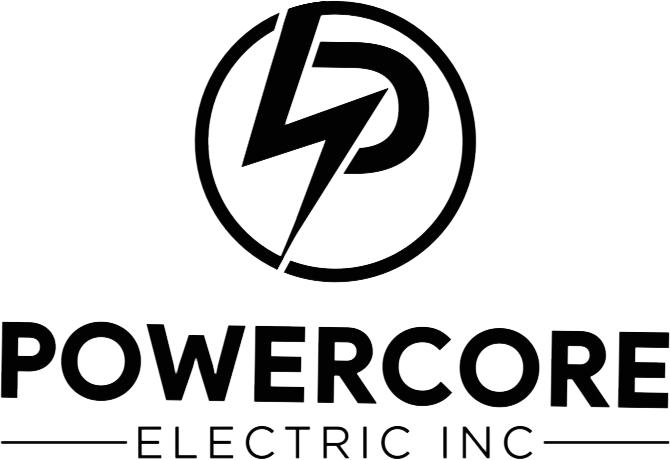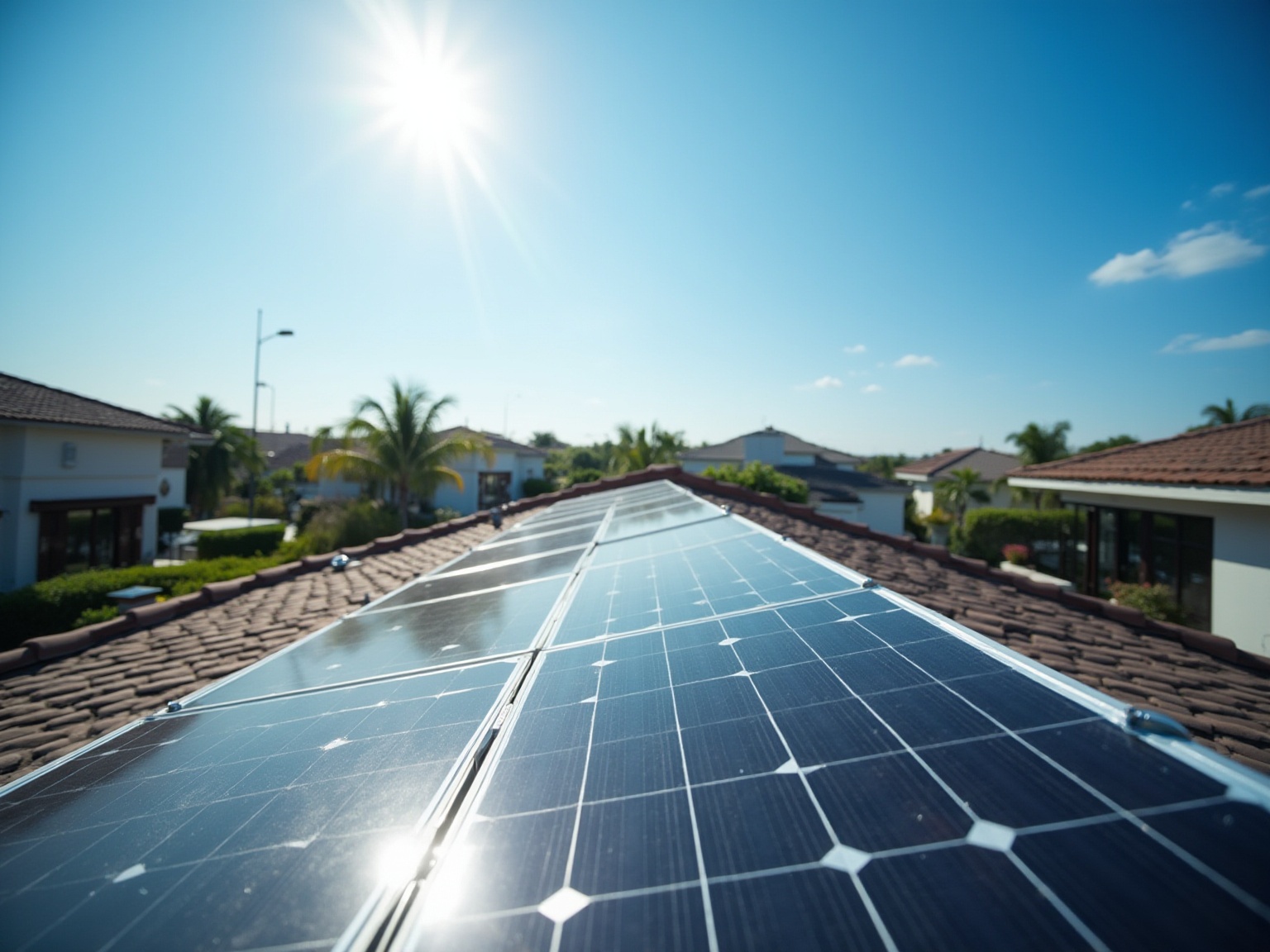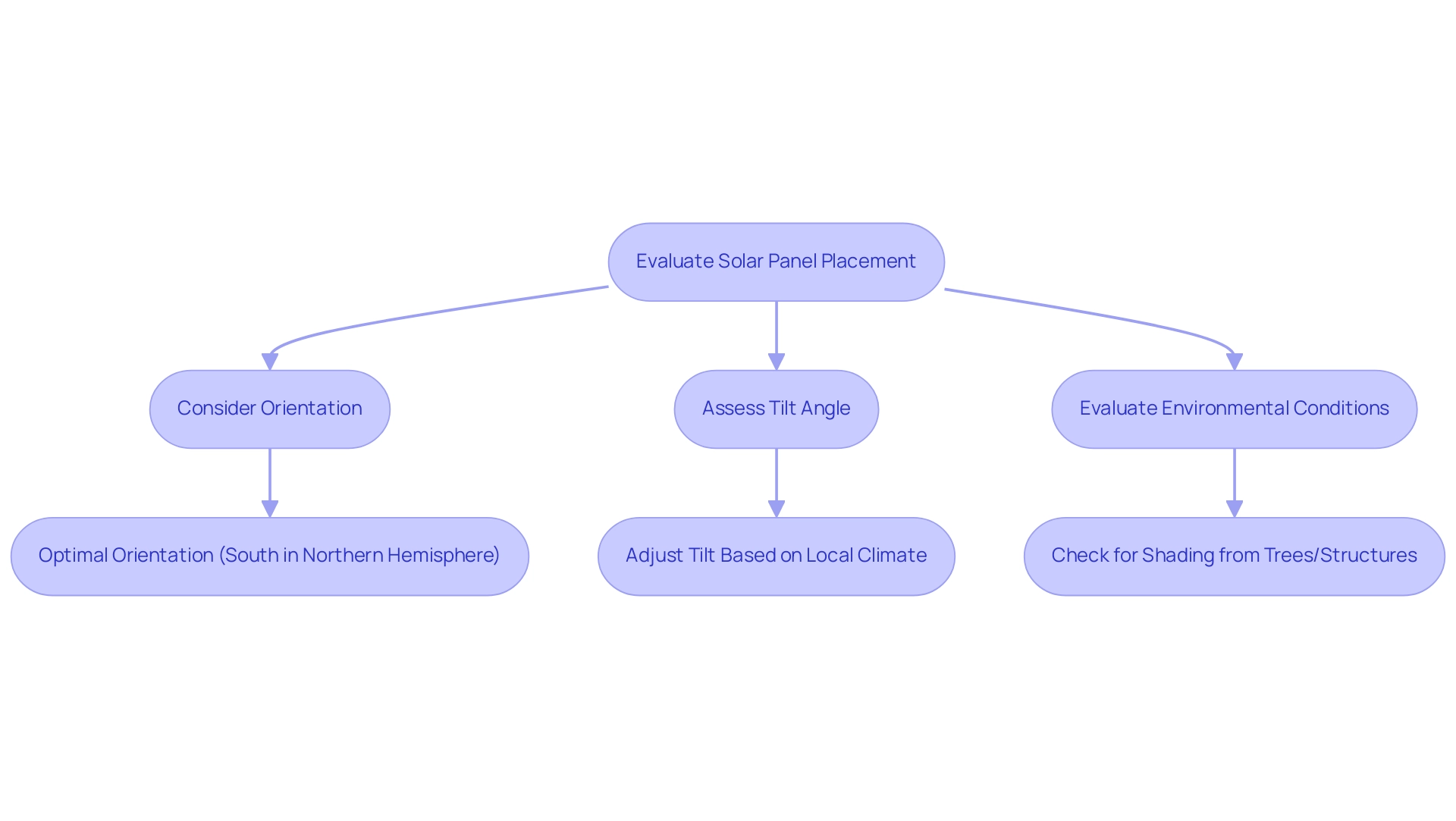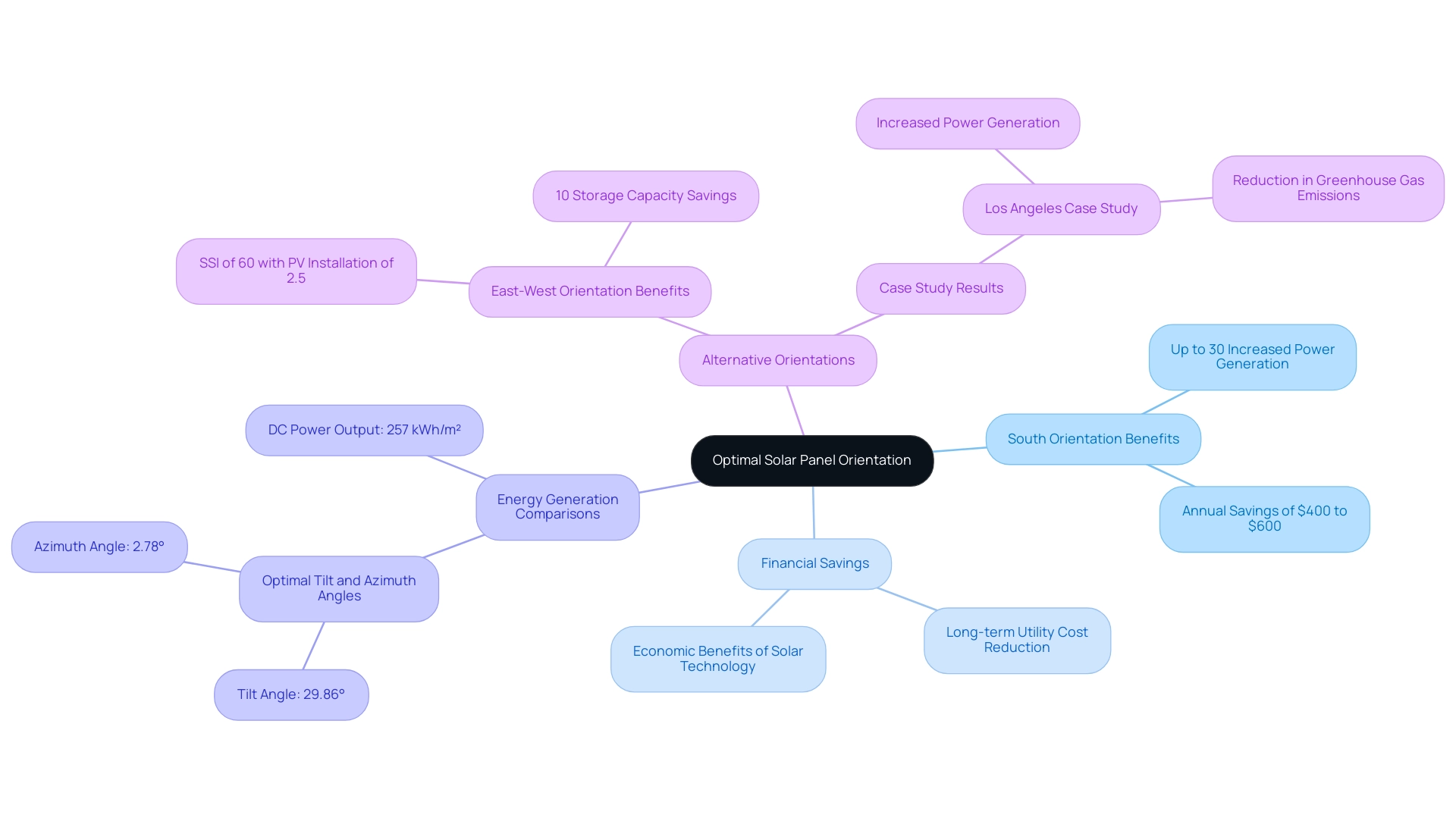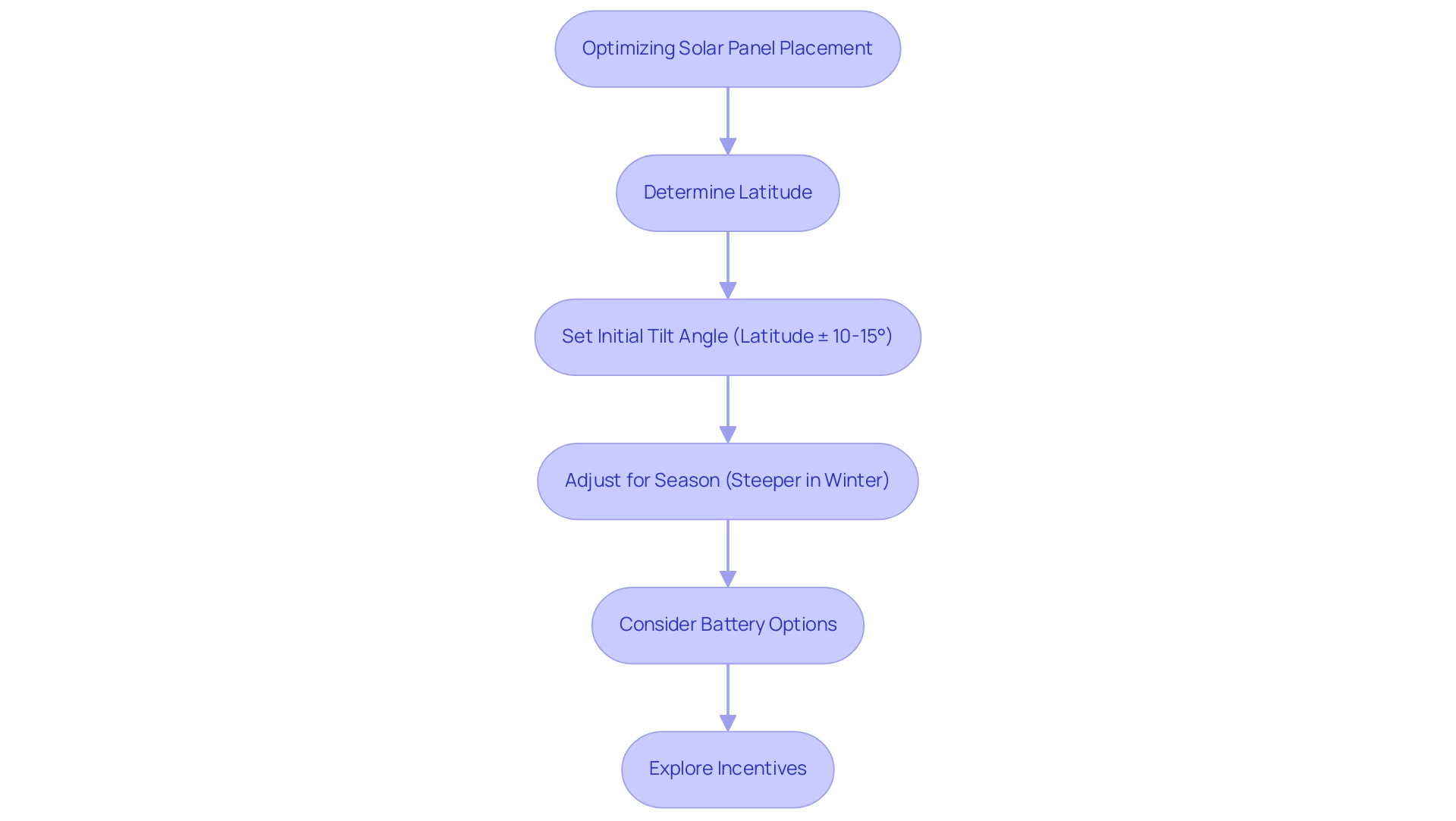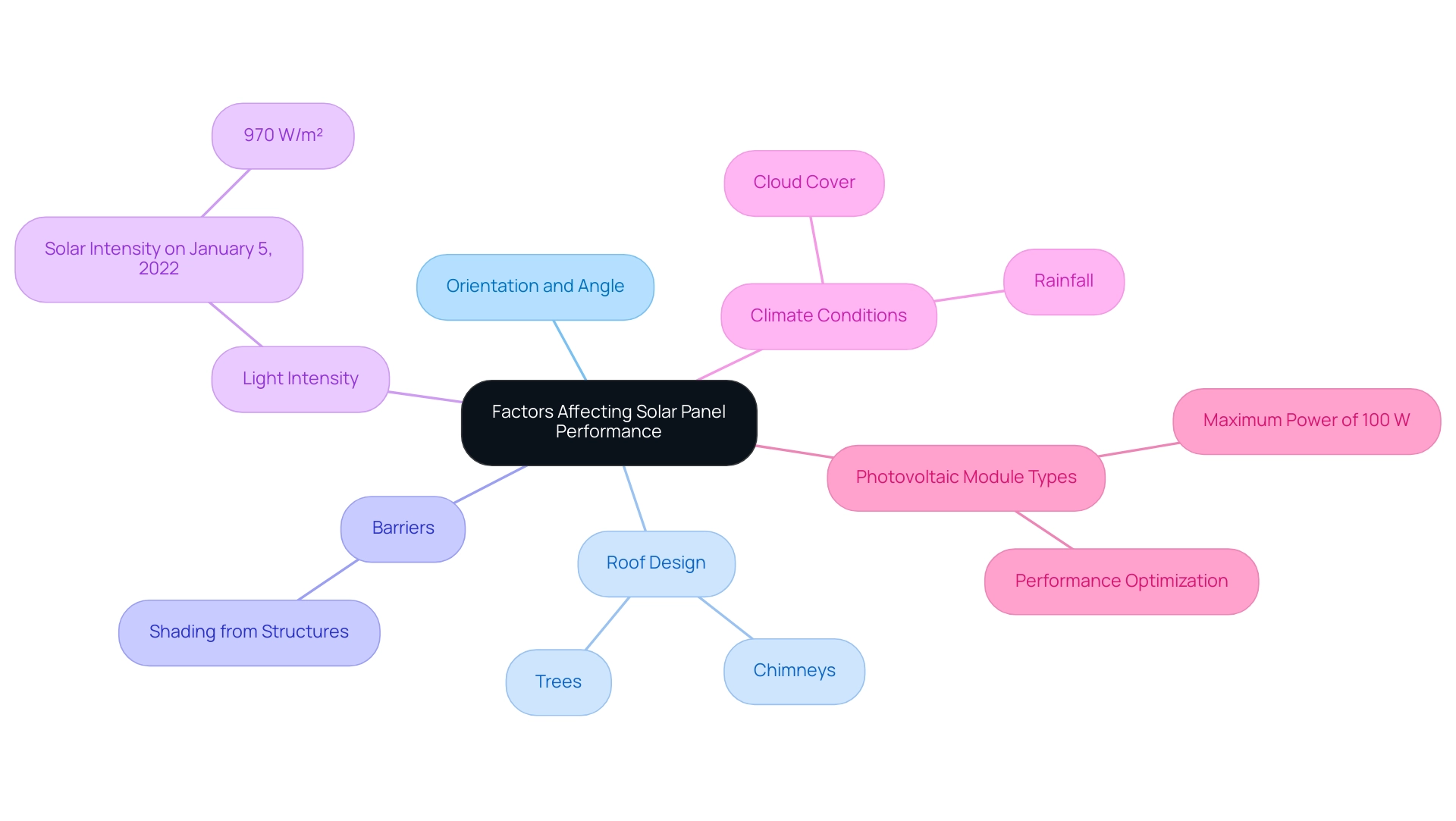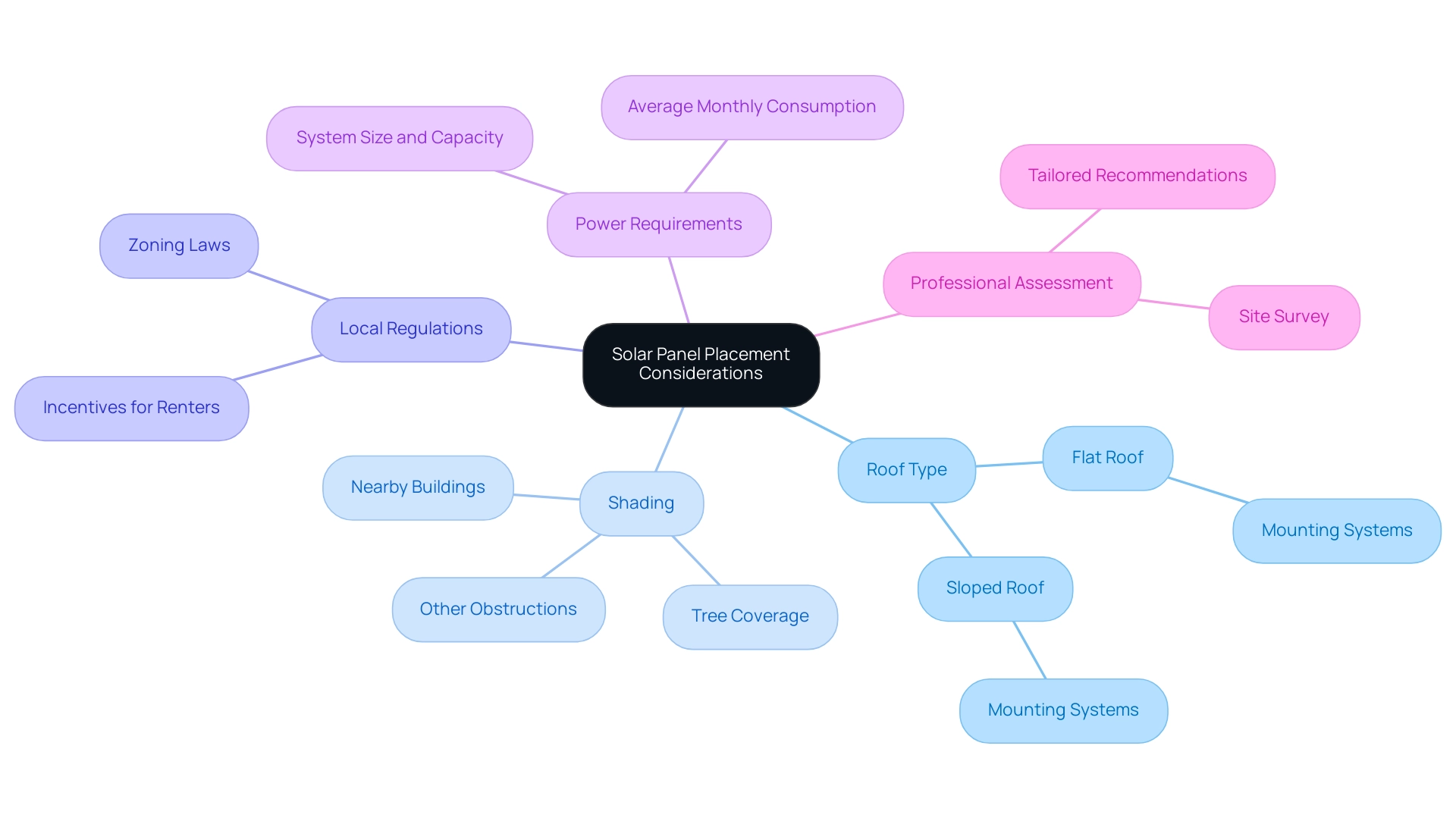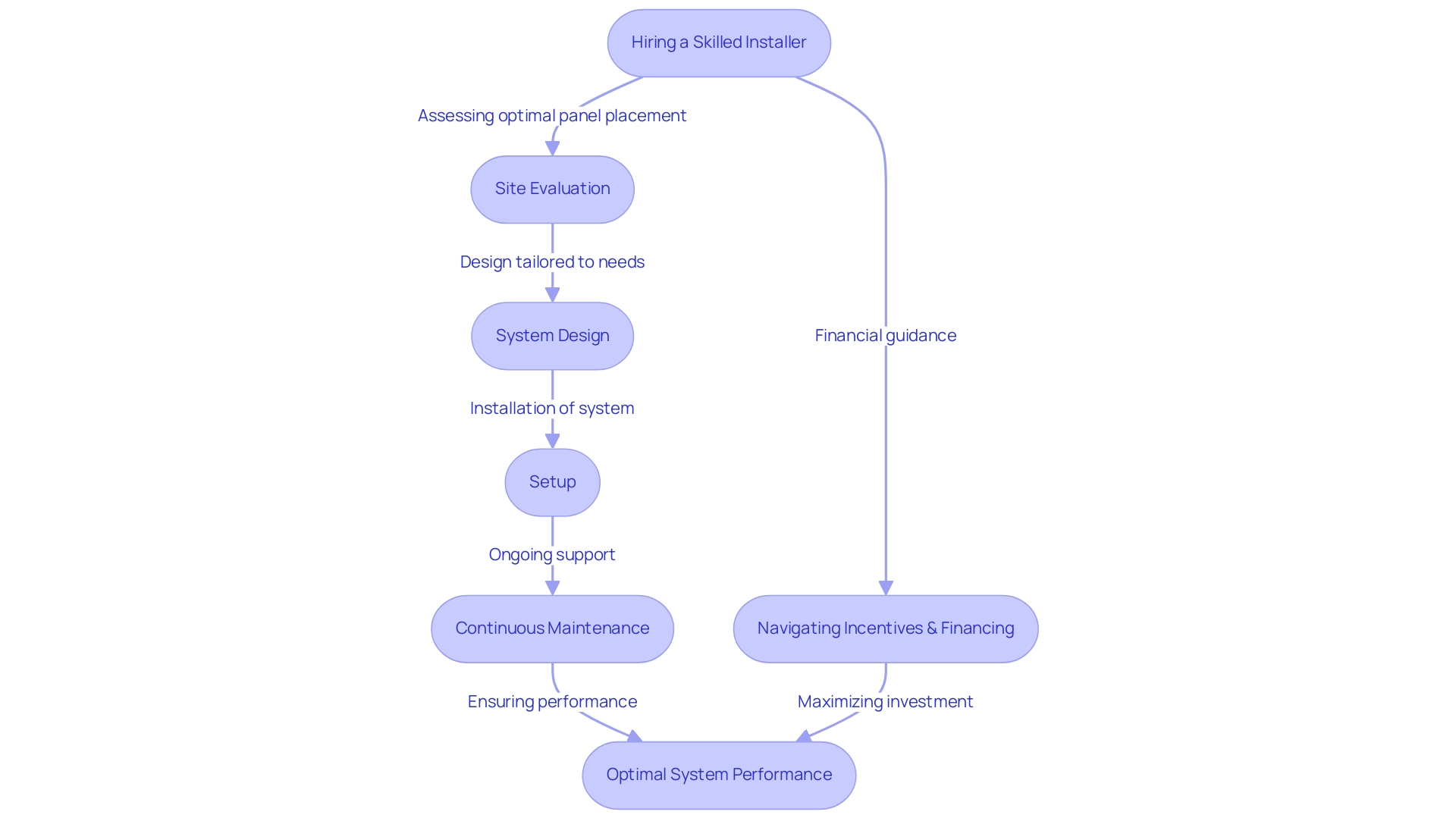Overview
We understand that navigating energy bills can be overwhelming, and finding ways to reduce those costs is a priority for many homeowners. The article focuses on the optimal placement of solar panels to maximize their efficiency, addressing key factors such as orientation, tilt angle, and shading. By detailing how south-facing panels can enhance power generation by up to 30%, it highlights the significant benefits of solar energy. It’s common to feel uncertain about the best approach, but considering local conditions and opting for professional installation can truly make a difference in achieving the best energy output. Together, we can explore these sustainable solutions that not only empower you but also contribute to energy independence. Let’s work towards a brighter, more efficient future for your home.
Introduction
As we increasingly shift towards sustainable energy solutions, many homeowners find themselves concerned about rising energy bills and the impact of their choices on the environment. The placement of solar panels has emerged as a vital factor in maximizing their efficiency and effectiveness. By discovering optimal positioning, you can significantly enhance energy production, translating to cost savings and a reduced carbon footprint.
However, we understand that navigating the complexities of solar panel installation—such as the best orientation, tilt angle, and environmental considerations—can feel daunting. This article delves into the critical aspects of solar panel placement, offering practical insights and tips for homeowners eager to harness the full potential of solar energy.
Together, we can explore the ideal direction for maximum sunlight exposure, recognize the impact of local regulations and shading, and empower you with valuable knowledge to make informed decisions about your solar investments. Let’s work towards a brighter, more sustainable future together.
Understanding the Importance of Solar Panel Placement
The placement of solar panels is crucial for optimizing the effectiveness of your solar power system. Thoughtfully positioned arrays can significantly enhance power generation, while less optimal placements may lead to considerable power loss and increased expenses. Key factors impacting efficiency include the orientation of the surfaces, their tilt angle, and environmental conditions such as shading from nearby trees or structures.
For instance, surfaces oriented directly south in the Northern Hemisphere typically receive ideal sunlight exposure throughout the day, resulting in greater power production. Additionally, understanding how your panels function is essential for selecting the best batteries, as effective energy storage solutions can further enhance performance. User manuals often provide detailed instructions on the optimal angles for setup, which can vary based on local climate and geographical conditions.
According to the Center for Sustainable Systems, the U.S. ranked second in photovoltaic setups in 2023 with 32.4 GW, reflecting a growing interest in efficient energy alternatives. Moreover, as of December 2022, there were 263,883 workers in the U.S. renewable energy sector, showcasing a robust 3.5% growth in the industry since 2021. This is particularly relevant for homeowners considering panel installation. A new renewable energy project is installed in the U.S. every 39 seconds, indicating a rapid embrace of this technology.
Recent trends in the community energy segment also reveal mixed performance; for example, it installed 291 MW in Q3 2024, highlighting regional disparities in development. Homeowners should also consider innovative cleaning solutions to maintain efficiency, as regular maintenance is crucial for optimal performance. Consequently, it’s important to thoughtfully evaluate the placement of your solar panels during setup to maximize the benefits of your energy investment.
By implementing optimal techniques in solar panels placement, along with routine upkeep and appropriate battery selections, you not only enhance power output but also align with broader objectives of boosting renewable capacity. Achieving a threefold rise in yearly renewable power additions by 2030 is vital for restricting global warming to 1.5°C. Together, we can make a meaningful impact on our environment while enjoying the benefits of energy independence.
The Best Direction for Solar Panels: Why South is Optimal
For property owners contemplating renewable power, it’s important to consider the best orientation for solar panel placement, which is primarily south. This orientation enables effective solar panel placement, allowing photovoltaic systems to capture sunlight for an extended period during the day, especially in the Northern Hemisphere. Studies suggest that south-oriented solar panels can enhance power generation by up to 30% compared to their east or west-oriented counterparts, directly contributing to savings on utility expenses.
Homeowners can look forward to saving between $400 to $600 each year on utility costs, highlighting the financial advantages of embracing renewable energy. A noteworthy study conducted in Los Angeles, California, found that an optimal tilt angle of 29.86° and an azimuth angle of 2.78° (slightly westward) achieved an impressive annual maximum insolation of 2236 kWh/m², resulting in a DC power output of 257 kWh/m². This optimized configuration not only provided a slight increase in power generation over conventional installations but also reflects the economic benefits of adopting solar technology.
Furthermore, experts like djh advocate for innovative orientations, stating, “The bifacial structures face east-west with a pivot Point North-south, rotate through 90 degrees, making the structure horizontal and equivalent to south-facing at 0 degrees.” While south-facing units generally excel in efficiency, solar panel placement in east-west orientations can also be advantageous in certain scenarios, particularly for maximizing energy production during peak usage hours. Notably, achieving a Solar Savings Index (SSI) of 60% with a PV installation of 2.5 indicates that 10% of storage capacity could be saved by orienting the PV to east/west.
Additionally, Scorp007’s MPPT operates efficiently without significant heat generation, further supporting the viability of various orientations. The economic implications of these orientations merit further investigation, underscoring the need for ongoing research to translate the benefits of east/west-oriented photovoltaic systems into financial terms, considering both operational and capital costs associated with different solar panel placements. A case study from a local homeowner illustrates that after installing south-facing photovoltaic systems, they not only significantly reduced their utility costs but also contributed to a decrease in greenhouse gas emissions, fostering sustainability.
This holistic approach not only enhances energy efficiency but also plays a crucial role in reducing greenhouse gas emissions, promoting sustainability, and ultimately benefiting homeowners financially. Together, we can embrace these solutions and work towards a greener future.
The Role of Angle in Solar Panel Efficiency
We understand that many homeowners are concerned about rising energy bills and are searching for sustainable solutions. The effectiveness of photovoltaic modules can significantly impact your energy costs, and their performance is greatly influenced by the placement of solar panels, their angle of setup, and the location itself. To optimize solar panel placement, it is ideal to tilt them at an angle that closely matches the latitude of your installation site. For instance, in beautiful San Diego, where the latitude is approximately 32.7° N, a tilt angle around 33° is recommended for optimal performance.
This thoughtful arrangement allows solar panels to be positioned perpendicularly to the sun’s rays during peak sunlight hours, maximizing power collection. Moreover, considering seasonal fluctuations can further enhance efficiency; adjusting the structures to a steeper angle during winter months is particularly effective for capturing power when the sun is lower in the sky. Studies suggest that maintaining the tilt of your photovoltaic system at the winter angle may suffice for areas with stable power requirements year-round, especially for applications like passive thermal heating in greenhouses.
It’s common to feel overwhelmed by the technicalities, but it’s important to note that mounts are typically aimed due south. However, adjusting the angle to about 10 degrees west of due south can further improve performance. As highlighted in the case study titled ‘Optimal Tilt Angle for Solar Panels Placement,’ homeowners can optimize seasonal production through proper solar panel placement by tilting panels at latitude minus 10-15° for summer or latitude plus 10-15° for winter. Furthermore, considering incorporating efficient battery systems to store surplus power can ensure a dependable electricity supply, even during times of reduced sunlight.
When choosing a battery for energy storage, options like the Tesla Powerwall are popular for their efficiency and compatibility with energy setups. As noted by industry experts, significant amounts of power can be gained pre and post noon elevation in many locations; that is to say, aiming for noon sun may not yield the best cumulative totals. Therefore, we encourage you to not only modify your solar panel placement according to your specific location and seasonal power requirements but also to explore alternatives like Tesla home chargers and government initiatives that promote renewable energy adoption, such as tax incentives and rebates. Together, we can ensure maximum efficiency and sustainability, paving the way for a brighter, more independent energy future.
Beyond Direction: Other Factors Affecting Solar Panel Performance
We understand that the orientation and angle of solar panel placement are critical for maximizing power capture. However, numerous other factors significantly influence their overall performance, especially for eco-conscious homeowners eager to promote renewable savings. By utilizing power storage options, property owners can save with photovoltaic systems, allowing them to store clean power for use during peak times. It’s important to consider roof design; for instance, the placement of solar panels can be affected by barriers like chimneys or adjacent trees that cast shadows, which can significantly decrease power generation.
A recent study on photovoltaic efficiency revealed that the light intensity recorded on January 5, 2022, reached 970 W/m², emphasizing the importance of unobstructed exposure to sunlight. Furthermore, local climate conditions play a crucial role; areas with frequent cloud cover or heavy rainfall may require customized strategies, including energy storage solutions, to improve efficiency. Homeowners should also reflect on the specific type of photovoltaic modules installed, especially noting that the device used in the investigation has a maximum power of 100 W, which is essential for understanding performance metrics.
Certain models are engineered to optimize performance under specific environmental conditions, making it vital to select the appropriate system based on individual circumstances. As highlighted by the authors of a comprehensive study, the findings provide valuable insights for optimizing power plant performance by understanding the relationship between efficiency and meteorological parameters. This interconnectedness of roof design, environmental factors, and photovoltaic technology is crucial for maximizing renewable power production and ensuring effective home protection through roofing enhancements.
Moreover, the research underscores the necessity for ideal solar panel placement sites for PV systems to enhance sunlight exposure and reduce shading. This aligns closely with the conversation on roof design and environmental aspects. For Long Beach tenants, understanding these dynamics empowers them to make informed choices regarding their renewable solutions, ensuring they can effectively save with renewable sources and protect their homes. Together, we can navigate these considerations to foster a sustainable future.
Practical Tips for Homeowners: Assessing Your Solar Panel Placement Needs
Before embarking on the journey of setting up photovoltaic systems, it’s essential for environmentally conscious Long Beach tenants to conduct a thorough evaluation of their property. This step is crucial for optimizing the solar panels’ placement, ensuring greater efficiency and effectiveness in your energy solution. Here are some key considerations to keep in mind:
- Roof Type: First and foremost, confirm that your roof can support the weight of photovoltaic systems and is in excellent condition for installation. Different roof types, such as flat or sloped, may require distinct mounting systems that influence both aesthetics and the placement of your solar panels.
- Shading: It’s common to feel uncertain about potential shading that could impact your solar panels. Identifying sources of shade throughout the day is critical; even partial shading can significantly hinder performance and reduce electricity output. Evaluating tree coverage, nearby buildings, or other obstructions is vital for ensuring optimal solar panel placement.
- Local Regulations and Incentives: Familiarize yourself with local zoning laws and regulations regarding photovoltaic installations. Understanding any available incentives specifically for Long Beach renters can make a significant difference, as these can vary widely by area and may influence the feasibility and design of your energy system.
- Power Requirements: Evaluating your household’s power usage is essential in determining the suitable size and capacity of your photovoltaic system. Comprehending your average monthly power consumption will guide you in choosing a system that can meet your needs efficiently.
- Professional Assessment: We understand that navigating these decisions can be overwhelming. Engaging a professional to conduct a site survey can provide tailored recommendations based on your specific circumstances. This specialist perspective can assist in determining the optimal placement of solar panels, taking into account shading, roof orientation, and power requirements.
Regarding financial factors, recent utility-scale prices for photovoltaic systems range from $16/MWh to $35/MWh, underscoring the cost-effectiveness of this renewable resource. Moreover, companies such as Amazon, Google, and Meta collectively possess a contracted pipeline exceeding 25 GW in renewable power, indicating a growing interest and investment in photovoltaic technology. A comprehensive cost examination contrasting renewable sources to conventional electricity shows that while upfront expenses can be considerable, long-term savings on utility bills frequently render renewable options a financially wise decision.
Additionally, various government programs can assist renters in overcoming financial barriers to installation. With predictions indicating a notable rise in residential renewable power usage in the U.S. from 2022 to 2050, appropriate planning and evaluation are essential for Long Beach tenants eager to embrace sustainable resources. Together, we can work towards a brighter, more sustainable future.
The Value of Professional Installation and Local Expertise in Solar Solutions
Hiring a skilled installer is crucial for improving both the efficiency and effectiveness of your renewable power system, particularly regarding the placement of solar panels. We understand that navigating this process can feel overwhelming, but these experts possess extensive knowledge of local regulations, best practices for solar panel placement, and optimal system designs tailored to your specific needs. In Stockton, renewable energy firms generally provide services like:
- Site evaluations
- System design
- Setup
- Continuous maintenance
This ensures that the placement of solar panels is customized to enhance energy output according to local climate and shading factors.
Moreover, professionals can guide you through available incentives and financing options, ensuring you leverage tax credits effectively to maximize your investment. It’s common to feel uncertain about these financial aspects, but rest assured that support is available.
The importance of professional installation is underscored by recent data indicating a 4% quarter-over-quarter decline in residential installations, yet the overall market outlook remains positive. This decline illustrates the necessity for informed decisions; homeowners relying on professional expertise can mitigate risks associated with these market fluctuations while ensuring optimal system performance. The Inflation Reduction Act has revitalized growth projections for photovoltaic deployment by 46%, creating new opportunities for homeowners.
Professionals can help navigate these changes, ensuring you capitalize on available incentives and financing options, making the hiring of an expert even more crucial in this evolving landscape. As one participant from a residential firm noted, the challenges faced in the market have necessitated adaptability and expertise, reinforcing the need for professional guidance to navigate these complexities. Additionally, comparing different solar service providers can reveal varying levels of service quality and pricing, which is essential for making an informed choice.
Ultimately, professional installation not only ensures that the placement of solar panels is conducted safely and correctly but also mitigates potential risks and issues that could arise in the future. Together, we can work towards a sustainable energy future that not only meets your needs but also contributes to a healthier planet.
Conclusion
We understand that the significance of solar panel placement is paramount when it comes to optimizing energy production and reducing costs for homeowners. Key factors such as direction, tilt angle, and environmental conditions play a crucial role in maximizing the efficiency of solar energy systems. For those in the Northern Hemisphere, south-facing panels generally yield the best results, enabling homeowners to significantly enhance their energy savings while contributing to sustainability efforts.
Moreover, it’s common to feel overwhelmed by the technical aspects of solar energy. Understanding the optimal angles based on geographic location and seasonal variations can further improve energy capture. We encourage homeowners to consider not only the positioning of their panels but also the surrounding environment, including shading from trees and nearby structures, which can markedly diminish energy output. Regular maintenance and the integration of efficient energy storage solutions are essential for sustaining performance and ensuring that solar investments yield long-term benefits.
Engaging professional installers who are familiar with local regulations is also vital in navigating the complexities of solar energy systems. Their expertise can help homeowners make informed decisions, ensuring that installations are optimized for both efficiency and compliance. As the solar industry continues to grow, the opportunity to harness clean energy while achieving substantial financial savings becomes increasingly accessible. By prioritizing proper placement and professional guidance, we can take significant strides toward a more sustainable future together—reducing both energy bills and our carbon footprint.
